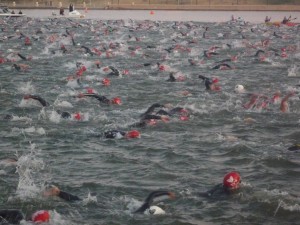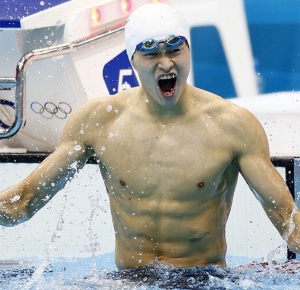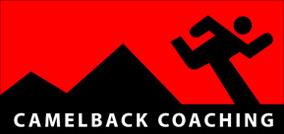Many triathletes believe they need a strong kick in swimming—that very fast, always-on kick. You know, that thing you do when coaches yell at you to “kick hard!”
“Kick hard!” they say. “Kick hard!”
So you do.
You grab your kickboard, you push off, and you kick like a maniac.
Some of you kick in place. Some of you inch forward. For the luckier ones, you make decent forward progress, but watch in despair, as your brethren with a swimming background move ahead of you with apparent ease, leaving you flailing in an attempt to keep up. Which you don’t.
“I can’t keep up with the group in kicking.”
“I don’t go anywhere when I kick.”
“I go backwards.”
“I’m just a slow kicker.”
Common laments.
I’m sure many of you have uttered these words or something similar at some point in your triathlon careers.
But then, think about this. You’re going to add arm movements to this very same kick, the one that is getting you nowhere and exhausts you. Arm movements that in terms of net propulsion allow you to move forward—hey! I’m moving forward—so it’s all good.
Why, oh why, would you do this?
How do you forget so quickly that you go nowhere with your kick alone, and yet, you add your arms and everything’s all right now?
Here’s a blinding flash of the obvious: Triathletes who do not come from a swimming background often have inefficient kicking mechanics.
And, based on my last eleven years of coaching, most do not have efficient kicking mechanics. The reason you stay in place or barely move forward when kicking is that you’re creating just as much drag as propulsion.
The solution? You obviously need more kicking sets. Just kick harder. Longer. It will work itself out.
[Ahem].
But for many, it does not work out. I talk about how to learn an efficient kick below, but in the meantime, for reasons of drag reduction, kicking less might not be such a bad thing.
“But if I’m kicking less, I’m not creating as much propulsion!”
True. But you’re also not creating as much drag.
Both of these things, kicking less and reducing drag, mean you don’t have to work as hard. Am I a proponent of two-beat kicking for long course triathletes for this reason? You betcha. Kick once per stroke—one leg kicking, while the other remains in streamline, nice and straight—a tight, hydrodynamic position that doesn’t create excess drag. Even a four-beat kick or a controlled and well-timed six-beat kick would be better than random splashing and flailing.
An integrated kick movement is an extremely powerful thing if harnessed correctly, and that’s the subject of the next blog article. But in this article, we’re talking drag reduction only.
And drag reduction is not cool. It is not what real coaches promote. The macho coaches. The ones who will overlook poor body position and breathing mechanics and horrible alignment and zero in on the catch as the problem. “You’re catch is slipping!” “Where’s that early vertical forearm?” “You’re dropping your elbow!” “Yep, fix that catch, kick hard, and you’re good!”
Sort of like polishing the seat on a chair with only three legs . . .
Am I ranting? Oops, didn’t mean to. Quiet, nerdy coaches don’t rant.
[But they do slip up sometimes.]
Is a good catch important? Heck, yeah! And I love working with athletes on their catch. It’s that fun stuff you get to do once the foundation is in order. But for 99% of the athletes I see for the first time, the foundation is not in order.
Things like . . . a streamlined, hip-initiated kick.
But before I go further, I want to say this. Is there value in the propulsion created by kicking hard in a 200-meter swim race? Yes. This is a short event and my assumption here is that the competitive swimmer who races this distance does so with an efficient kick.
You see this even in long distance swim races, like the 1500-meter freestyle, when the kick really “kicks” in for the last 50 meters or the last 100 meters, because the swimmer can move faster this way for that short burst of speed to the finish.
Which brings up another important point. Do competitive swimmers adjust how hard they’re kicking depending on the distance they’re racing? I think even the layperson could answer that. Swimmers racing a 50-meter race or a 100-meter race look different than the swimmer racing a 1500-meter event, do they not?
So even in a sport so dominated by this need for powerful, strong kicking, even here, adjustments are made to accommodate for distance.
So, if you’re a triathlete . . . who swims 3800 meters . . . who is in the water for an hour or ninety minutes or more . . . who must mount a bike after swimming and begin a further eight to fifteen hours of fat-burning-yet-glycogen-dependent athletic endeavor . . . are you going to kick like you would for 200 meters?
Please tell me, no.
“Well, that’s all well and good, Coach Anne, but how do I fix my inefficient kick and reduce drag, so I can get on to the business of working on cool things like the catch?”
Heighten your awareness of how much kicking you’re actually doing.
First, it’s important for you to tune into what you’re feeling in the water. What does it feel like to be streamlined and hydrodynamic?
I often tell my swimmers to envision a shark. They swim with lethal ease don’t they? Millions of years of evolution behind a shark’s movement to help it swim efficiently. A single flick of the tail and they change direction, right? They move purposefully, stealthily.
If a shark is spastically flicking its tail, creating bubbles and whitewash, it’s probably dying.
So the next time you’re in the pool, pay attention. Push off in a nice tight streamline, legs straight, feet together, toes pointed, and enjoy that sensation of slicing through the water, nothing impeding your forward progress.
And then—dare I suggest it—try stopping your kick between strokes. Just stop kicking and see what happens. It might just be for a micro-moment, a tiny beat in the many beats of a stroke cycle, but one that won’t create drag if your legs are straight and together and toes pointed. And this is for feel, mind you. Are you ever going to stop dead in the water when you’re swimming normally? No, of course not. But we get in this panicked habit of always kicking, always thrashing around on the back end, and we don’ t even realize we’re doing it.
If you find my streamlining experiment difficult—many other balance issues might be at work here—try it in your wet suit. It’s amazing how many triathletes’ breathing problems have been miraculously solved by allowing their legs to float in a wet suit. I say “float,” because this is what I tell swimmers to do sometimes—stop all movement and just use the arms—which means they usually don’t stop kicking, but they do kick less, which is the point.
Learn a hip-initiated kick.
After heightening your awareness as to the amount of kicking you’re doing, the second piece is to learn to kick from the hip, so that the motions you are making, regardless of the frequency and intensity, are at least close to a proper freestyle flutter kick.
The vertical kicking drill is a great drill to address a hip-initiated kick movement. Begin in deep water, body vertically oriented (like you’re standing), hands across your chest, and kick in place. You should strive to draw your leg back in a straight manner (no bend in the knee) behind your hip to initiate the kick, then bend your knee, then sweep the thigh forward and snap the leg straight, finishing with a pointed toe.
- The legs should move in an equidistant manner fore and aft of your longitudinal centerline.
- Sweep the leg forward as if scraping your toes along the bottom of the pool.
- Don’t lift the thigh, like you’d do in a running stride, but sweep it forward.
- If you’re doing the drill correctly, you should be able to keep your head above water and remain in place.
- If you move backwards, you’re kicking too much in front of you—not pulling your legs behind your hips to initiate the movement.
- If you sink—and many of you will the first time you try this—you are probably kicking at the knees only. Try big sweeps of the legs, like doing the splits, just to bring your awareness to the pivot point of the kicking action, which should be the hips. Once the pivot point is assured at the hips, you can reduce the amplitude of the kick.
I think the old adage, “work smarter, not harder,” is applicable here. So before you resign yourself to swimming into that proverbial brick wall with heart-pumping, glycogen-wasting kicking, remember what you’re training for, and then seek to do it more efficiently.




